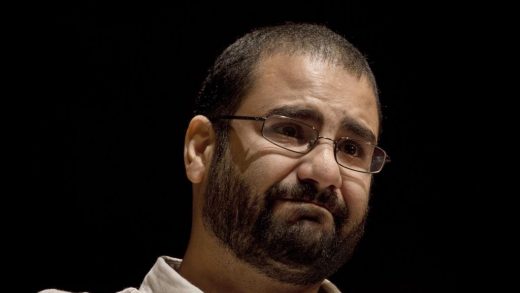Deadly chaos at Gaza aid convoy is a symbol of the desperation enveloping the territory

RAFAH, Gaza Strip (AP) — The chaos punctuated by heavy Israeli fire that killed 115 Palestinians trying to get bags of flour from an aid convoy highlights the desperation of the hundreds of thousands struggling to survive amid the devastation of northern Gaza after nearly five months of fighting between Israel and Hamas.
Residents say they have taken to searching piles of rubble and garbage for anything to feed their children, who barely eat one meal a day. Many families have begun mixing animal and bird food with grain to bake bread. International aid officials say they have encountered catastrophic hunger.
“We’re dying from starvation,” Soad Abu Hussein, a widow and mother of five children who has taken shelter in a school in the Jabaliya refugee camp, said Saturday.
Northern Gaza has borne the brunt of the conflict that began when Hamas launched an attack into southern Israel on Oct. 7, killing 1,200 people, mostly civilians, and seizing around 250 hostages.
Israel’s air, sea and ground offensive, reduced much of the densely populated area to rubble. The military told Palestinians to move south, but as many as 300,000 people are believed to have remained.
Roughly one child in six children under the age of 2 in the north suffers from acute malnutrition and wasting, “the worst level of child malnutrition anywhere in the world,” Carl Skau, deputy executive director of the World Food Program, said this week. “If nothing changes, a famine is imminent in northern Gaza.”
That has caused such desperation among the people living there that they have overwhelmed trucks delivering food aid to the region and grabbed what they can, Skau said, forcing the World Food Program to suspend aid deliveries to the north.
“The breakdown in civil order, driven by sheer desperation, is preventing the safe distribution of aid — and we have a duty to protect our staff,” he said.
In the violence Thursday, hundreds of people rushed a group of about 30 trucks bringing a pre-dawn delivery of aid to the north. Palestinians said nearby Israeli troops shot into the crowds. Israel said they fired warning shots toward the crowd and insisted many of the dead were trampled in the stampede. Doctors at hospitals in Gaza and a U.N. team that visited a hospital there said large numbers of the wounded had been shot.
Ahmed Abdel Karim, who was being treated at Kamal Adwan Hospital for gunshot wounds in his feet, said he had spent two days waiting in the area for aid trucks to arrive before Thursday’s convoy came.
“Everyone attacked and advanced on these trucks. Because of the large number, I could not get flour,” he said. He was then shot by Israeli troops, he said.
Radwan Abdel-Hai, a father of four young children, heard a rumor late Wednesday that an aid convoy was on its way. He and five others took a donkey cart to meet it and found a “sea of people” waiting for the aid.
When the convoy arrived, people spread toward the trucks to grab whatever food and water they could get, he said. As they reached the trucks, “tanks started firing at us,” he said. “As I ran back, I heard tank shells and gunfire. I heard people screaming. I saw people falling to the ground, some motionless.” Abdel-Hai fled and took shelter in a nearby building along with others. When the shooting stopped, many dead people were lying on the ground, he said. “We rushed to help evacuate the wounded. Many were shot in their back,” he said.
Abu Hussein, the widow, said that more than 5,000 people — mostly women and children — living with her in the Jabaliya school have not received any aid for more than four weeks. Adults eat one meal or less to save food for the children, she said.
A group of people went to the shore to try to fish, but three were killed and two were wounded by gunfire from Israeli ships, she said. “They just wanted to get something for their children.”
The Israeli military did not immediately respond to a request for comment.
Mansour Hamed, a 32-year-old former aid worker living with more than 50 relatives in a Gaza City house, said people are resorting to desperate measures to find something to eat. Some are eating tree leaves and animal food. Some sift through the rubble and abandoned houses for old food. It has become normal to find a child coming out of the rubble with a rotten piece of bread, he said.
“They are desperate. They want anything to stay alive.”
Acknowledging the difficulty of getting aid in and the extreme need for food, U.S. President Joe Biden said Friday the U.S. soon will begin airdropping assistance to Gaza and will look for other ways to get shipments in, “including possibly a marine corridor.”
Aid workers were hoping a possible cease-fire would allow them to get food to hungry people across Gaza. A senior Egyptian official said cease-fire talks would resume Sunday in Cairo. The official spoke on condition of anonymity because they were not authorized to speak to the media.
International mediators hope to reach agreement on a six-week pause in fighting, and an exchange of some Israeli hostages for Palestinians imprisoned by Israel, before the Muslim holy month of Ramadan begins around March 10.
Meanwhile, the fighting continued. The Gaza Health Ministry said the Palestinian death toll from the war has climbed to 30,320. The ministry doesn’t differentiate between civilians and combatants in its figures, but says women and children make up around two-thirds of those killed.
___
Magdy reported from Cairo.
___
Find more of AP’s coverage at https://apnews.com/hub/israel-hamas-war
Credit: Deadly chaos at Gaza aid convoy is a symbol of the desperation enveloping the territory


